Related Research Articles

The Liberty Bell, previously called the State House Bell or Old State House Bell, is an iconic symbol of American independence located in Philadelphia. Originally placed in the steeple of the Pennsylvania State House, the bell today is located across the street in the Liberty Bell Center in Independence National Historical Park. The bell was commissioned in 1752 by the Pennsylvania Provincial Assembly from the London firm of Lester and Pack, and was cast with the lettering "Proclaim LIBERTY Throughout all the Land unto all the Inhabitants Thereof", a Biblical reference from the Book of Leviticus. The bell first cracked when rung after its arrival in Philadelphia, and was twice recast by local workmen John Pass and John Stow, whose last names appear on the bell. In its early years, the bell was used to summon lawmakers to legislative sessions and to alert citizens about public meetings and proclamations.
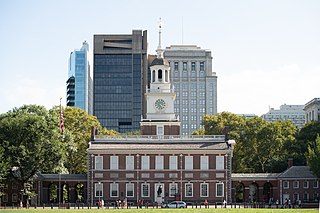
Independence Hall is a historic civic building in Philadelphia, where both the United States Declaration of Independence and the United States Constitution were debated and adopted by America's Founding Fathers. The structure forms the centerpiece of the Independence National Historical Park. Independence Hall was named to the National Register of Historic Places in 1966 and as a World Heritage Site in 1979.

The Province of Pennsylvania, also known as the Pennsylvania Colony, was a British North American colony founded by William Penn, who received the land through a grant from Charles II of England in 1681. The name Pennsylvania was derived from "Penn's Woods", referring to William's father Admiral Sir William Penn.
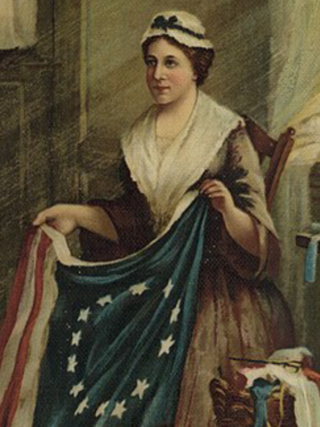
Elizabeth Griscom Ross, also known by her second and third married names, Ashburn and Claypoole, was an American upholsterer who was credited by her relatives in 1870 with making the first official U.S. flag, accordingly known as the Betsy Ross flag. Though most historians dismiss the story, Ross family tradition holds that General George Washington, commander-in-chief of the Continental Army and two members of a congressional committee—Robert Morris and George Ross—visited Mrs. Ross in 1776. Mrs. Ross convinced George Washington to change the shape of the stars in a sketch of a flag he showed her from six-pointed to five-pointed by demonstrating that it was easier and speedier to cut the latter. However, there is no archival evidence or other recorded verbal tradition to substantiate this story of the first U.S. flag. It appears that the story first surfaced in the writings of her grandson in the 1870s, with no mention or documentation in earlier decades.

The Sons of Liberty was a loosely organized, clandestine, sometimes violent, political organization active in the Thirteen American Colonies founded to advance the rights of the colonists and to fight taxation by the British government. It played a major role in most colonies in battling the Stamp Act in 1765 and throughout the entire period of the American Revolution.

Congress Hall, located in Philadelphia at the intersection of Chestnut and 6th Streets, served as the seat of the United States Congress from December 6, 1790, to May 14, 1800. During Congress Hall's duration as the capitol of the United States, the country admitted three new states, Vermont, Kentucky, and Tennessee; ratified the Bill of Rights of the United States Constitution; and oversaw the presidential inaugurations of both George Washington and John Adams.

Independence National Historical Park is a federally protected historic district in Philadelphia, Pennsylvania that preserves several sites associated with the American Revolution and the nation's founding history. Administered by the National Park Service, the 55-acre (22 ha) park comprises many of Philadelphia's most-visited historic sites within the Old City and Society Hill neighborhoods. The park has been nicknamed "America's most historic square mile" because of its abundance of historic landmarks.

The Tomb of the Unknown Revolutionary War Soldier, also known as the Tomb of the Unknown Soldier of the American Revolution, is a war memorial located within Washington Square in Philadelphia, Pennsylvania. The memorial honors the thousands of soldiers who died during the American Revolutionary War, many of whom were buried in mass graves in the square. The tomb and Washington Square are part of Independence National Historical Park.
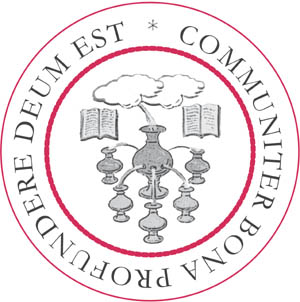

Pennsylvania was the site of many key events associated with the American Revolution and American Revolutionary War. The city of Philadelphia, then capital of the Thirteen Colonies and the largest city in the colonies, was a gathering place for the Founding Fathers who discussed, debated, developed, and ultimately implemented many of the acts, including signing the Declaration of Independence, that inspired and launched the revolution and the quest for independence from the British Empire.

Mikveh Israel Cemetery is the oldest Jewish cemetery in Philadelphia, Pennsylvania, giving evidence of a settled community as early as 1740. A number of outstanding patriots, pioneers, and other notables of the Jewish faith who made important contributions to the history and freedom of America during the Colonial and Revolutionary period were interred here, and for this reason, in 1959, by an act of Congress, the burial ground was designated as a unit of the Independence National Historical Park, while continuing to be maintained by the sponsoring Congregation Mikveh Israel. The cemetery was certified by the Philadelphia Historical Commission, and in 1971, it was listed on the National Register of Historic Places.

The Betsy Ross House is a landmark in Philadelphia purported to be the site where the seamstress and flag-maker Betsy Ross (1752–1836) lived when she is said to have sewed the first American Flag. The origins of the Betsy Ross myth trace back to her relatives, particularly her grandsons, William and George Canby, and the celebrations of the Centennial of 1876. Evidence for the precise location of Ross's home came from verification provided by several surviving family members, although the best archival evidence indicates the house would have been adjacent to the one that still stands today as The Betsy Ross House. The 1937 Philadelphia Guide noted that, after the current Betsy Ross House was selected as the Flag House, the adjacent building where Ross may have indeed lived "was torn down to lessen the hazards of fire, perhaps adding a touch of irony to what may well have been an error in research." Although the house is one of the most visited tourist sites in Philadelphia, the claim that Ross once lived there, and that she designed and sewed the first American flag, sometimes called the Betsy Ross flag, are considered false by most historians.

Edmund Woolley (c.1695—1771) was an English-born American architect and master carpenter, best known for building Independence Hall in Philadelphia, Pennsylvania, United States.
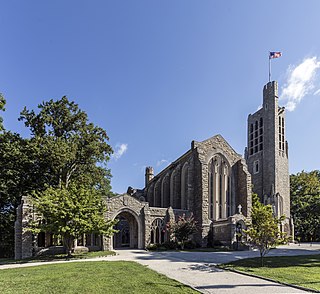
Washington Memorial Chapel in Valley Forge National Historical Park is a national memorial dedicated to General George Washington and an active Episcopal parish in Valley Forge, Pennsylvania. The church was inspired by a sermon preached by Anglican minister Reverend Dr. W. Herbert Burk, founder and first rector of the parish. The building was designed by architect Milton B. Medary. It was listed on the National Register of Historic Places on May 1, 2017, and is undergoing an active restoration campaign.
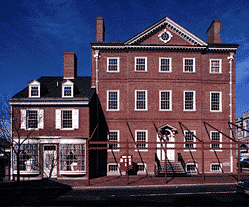
The City Tavern is a late-20th century building designed to be the replica of the historic 18th-century tavern and hotel building which stood on the site. It is located at 138 South 2nd Street in Philadelphia, at the intersection of Second and Walnut Streets, near Independence Hall. The original 18th century building was frequented by the Founding Fathers of the United States and other distinguished people. High-profile events took place there, including the first anniversary celebration of the 4th of July.

The President's House in Philadelphia was the third U.S. Presidential Mansion. George Washington occupied it from November 27, 1790, to March 10, 1797, and John Adams occupied it from March 21, 1797, to May 30, 1800.

The Liberty Bell Museum is a non-profit organization and museum located in Zion's United Church of Christ in Allentown, Pennsylvania in the Lehigh Valley region of eastern Pennsylvania. The museum is based in the church in which the Liberty Bell, an iconic and globally-recognized symbol of America's independence, was hidden from the British Army by Allentown-area American patriots during the American Revolutionary War from September 1777 to June 1778.

The High German Evangelical Reformed Church, also known as Zion Reformed and Zion United Church of Christ, is an historic Evangelical and Reformed church, which is located at 622 West Hamilton Street in Allentown, Pennsylvania in the Lehigh Valley region of eastern Pennsylvania.

The Museum of the American Revolution, formerly The American Revolution Center, is a museum in Philadelphia, Pennsylvania dedicated to telling the story of the American Revolution. The museum was opened to the public on April 19, 2017, the 242nd anniversary of the Battles of Lexington and Concord, the first battles of the American Revolutionary War, on April 19, 1775.

The Pennsylvania Provincial Conference, officially the Provincial Conference of Committees of the Province of Pennsylvania, was a Provincial Congress held June 18–25, 1776 at Carpenters' Hall in Philadelphia. The 97 delegates in attendance involved themselves in issues relating to declaring Pennsylvania's support for independence and to planning for a subsequent gathering that would develop Pennsylvania's new Frame of Government. They achieved these objectives by formally:
References
- ↑ "Judge Edwin O. Lewis". Independence Hall Association. Retrieved 2008-08-27.
- 1 2 "History of the Independence Hall Association". Independence Hall Association. Retrieved 2008-08-27.
- ↑ "About ushistory.org". Independence Hall Association. Retrieved 2014-01-05.